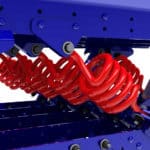Conveyor Parts
Conveyors are ideal for transporting and handling a wide range of materials across different industries, from handling castings in foundries to aggregates in mines. Conveyors come in a variety of types, including belt, roller, chain, and vibratory conveyors. Additionally, conveyors are sometimes interlinked throughout a facility to create a conveyor system.
While a relatively simple piece of equipment on the surface, internally, conveyors use a wide array of components and moving parts that work together to transport materials as efficiently as possible through continuous motion. Knowing what these functions do can help you identify problems as they arise and address them effectively, minimizing downtime and maintenance.
Vibratory Conveyor Parts
Vibratory conveyors are ideal for applications where you’re handling hotter materials, such as castings, or where you need to transport materials around corners or up inclines, or where heavy-duty transport surfaces are required. To operate smoothly, vibratory conveyors are made up of a variety of parts, each performing a unique function to keep your material moving.
Springs

Reactor Springs: Reactor springs are pigtail-mounted coil springs used to transfer force between the exciter and machine body on Two-Mass vibratory equipment.
Drive Springs: Pigtail-mounted coil springs used between the drive bracket and eccentric arm on vibratory drives.
Isolation Springs: A coil spring used between support steel and vibrating equipment to isolate the transmission of vibration to the ground.
Marshmallow Springs: Rubber springs are used between the support steel and the vibratory equipment to isolate vibration transmission into the ground.
DURO-SPRING™: GK’s patented DURO-SPRING™ allows for higher stroke capacity, improving machine productivity and performance. Used in applications where easy access for maintenance and maximum stroke performance are a requirement.
Springs are one of the most critical components of vibratory conveyors. Choosing the right spring for your application can mean the difference between constant maintenance and efficient material handling.
Rocker Legs/Stabilizers
Rocker legs are structural components that provide support and stability. Typically used on vibratory and shaking conveyors, they protect the equipment’s integrity and ensure smoother operation by minimizing unwanted movements.
Bearings
Bearings are mounted to a surface that houses a rotating shaft, enabling the shaft to rotate freely while remaining securely attached to the equipment and bearing.
Drive
Drives generate the vibrations that move materials along the surface of a conveyor from one end to the other. Depending on the material being conveyed, different types of drives may be utilized. Additionally, the drive is sometimes mounted in various areas for different applications.
Drives for vibratory conveyors are mechanisms that create the vibrations needed to move material along a trough. The main types of drives used in these conveyors are mechanical, electromagnetic, and out-of-balance (or unbalanced) motor drives, each suited to specific applications and material characteristics.
Belt Conveyor Parts
Because belt conveyors are often used for different functions than vibratory conveyors, belt conveyor parts are more varied than vibratory conveyor parts.
Belts
Belts are the surface used to carry materials from one end of the conveyor to the other. Belts are made of a variety of materials depending on the application. Conveyor belts consist of two main parts: the carcass and the covers. The carcass is like a ‘skeleton’ made from tightly woven fabric, determining the belt’s support, stiffness, shape, impact resistance, and tension. The belt cover—generally made of rubber, a rubber compound, metal, or modular plastics—protects the conveyor’s carcass from transported materials and extends the conveyor’s lifespan.
Belt materials typically consist of one of the following:
- PVC (Polyvinyl Chloride): Versatile, affordable, and resistant to oils and chemicals, suitable for light to medium-weight packages. Not good for high-temperature applications, such as foundries.
- Rubber: Highly durable with excellent impact resistance, ideal for heavy-duty applications and abrasive materials. It can degrade if exposed to chemicals, oils, and high-temperature applications.
- Polyurethane: Lightweight, wear-resistant, with good elasticity, perfect for long-distance conveying. Very vulnerable to high-temperature applications.
- Metal: Stainless steel, carbon steel, or aluminum for extreme durability and high-temperature resistance. Typically come as Plate Conveyors.
- Fabric: Woven polyester or nylon, cost-effective for light to medium applications. More susceptible to tears when handling sharper or rigid objects.
- Silicone: Excellent for extreme temperatures in bakeries and frozen food processing
- PTFE: Superior heat and chemical resistance for specialty applications
- Nitrile Rubber: High resistance to oils and chemicals
Rollers
Rollers are cylinders attached to the conveyor bed via bearings. They are combined with low-horsepower motors that move materials over the belt surface. Usually, these parts are made of steel, plastic, MDR, rubber, split rollers, or pallet rollers.
O-Rings
O-shaped rubber bands are routed through channels on rollers. Allow multiple rollers to spin to provide continuous forward movement as products pass. Ensures packages don’t stop or jam during transport.
Pulleys
Pulley systems are routed through the conveyor bed. Pulleys provide stable motion through maintained tension, tracking, traction, and direction. Mainly used on belt conveyors, but can be used on chain conveyors.
Motor/Drive
Like vibratory conveyors, the motor powers the conveyor’s moving components, enabling them to move materials effectively. Typically drum-mounted, side-mounted, or under-bed mounted.
Bearings
Provide support, reduce friction, and facilitate belt motion. Typically mounted on conveyor rollers, pulleys, and rotating components. Rotate freely while minimizing wear and tear. Enable efficient, reliable conveyor belt movement to smoothly and consistently transport materials.
Brakes
Safety feature used to halt or slow the movement of conveyors/components. Prevent belt slippage, used for emergencies, primarily a safety feature.
Guardrails
Another safety component. Work as a barrier to prevent materials from falling off, damaging equipment, or harming personnel.
Keep Your Conveyor Running with GK Parts
Well-designed and maintained conveyor parts can make or break your material handling system. That’s why, when you’re replacing conveyor components, you should only use the most reliable, durable parts. If you need a dependable source for your conveyor parts, look no further than GK Parts!






